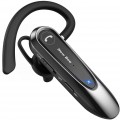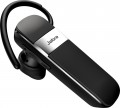Design
The design of the earpiece used in a Bluetooth headset.
—
Earbuds. A small earpiece located in the auricle outside the auditory canal (as opposed to in-ear). The unequivocal advantages of inserts are simplicity and low cost. The sound insulation of such devices turns out to be rather weak, which can be both a minus and a plus: the earbud is not suitable for a noisy environment, but it almost does not interfere with hearing. But the sound quality of the earbuds is somewhat lower than that of the in-channel counterparts. In addition, such an earpiece is less securely held in the ear and is more difficult to adjust to the individual biological nuances of a person (although interchangeable nozzles of different sizes are available for the earbuds).
—
In-ear. An earpiece that, during use, is inserted deep into the ear canal and held there by a soft cap made of silicone or other similar material. These headphones are considered more advanced than earbuds: at lower volume (and less power consumption), they provide more powerful and rich sound. The unequivocal disadvantages of in-ear models include a higher cost. In addition, a high degree of sound insulation can create inconvenience: when using such headsets, ear is almost completely closed. On the other hand, it allows you to hear the sound well even in a rather noisy environment.
Behind ear
A device designed to fix the device on the auricle; most often represents a signature shackle. Such a shackle is very popular among Bluetooth headsets — this is the easiest way to hold a relatively large device on your ear. At the same time, ultra-compact models can be fixed directly in the ear and do not need a behind-the-ear
hook. And for car kits and speakerphones (see "Device"), such a mount is not required.
Note that the shackle is most often made swivel, which allows you to reposition it from the left to the right ear and vice versa.
Connection
—
Mini-Jack (3.5 mm). Mini-Jack is one of the most popular wired connectors. However, it is not used in Bluetooth headsets, and it is extremely rare in other specialized accessories and predominantly is an auxiliary feature. So, in speakerphones, mini-Jack is usually responsible for connecting several devices to each other, and in car kits, for outputting sound to the radio or standard car acoustics. Note that in this case, the headphone jack is not considered a 3.5 mm jack, although it is most often performed in this format.
— USB A. The classic USB A computer connector, which is gradually being replaced by the USB-C connector. The meaning and application of this connection depends on the type of device. So,
USB in speakerphones is a standard port for wired connection — both to computers and to specialized communication systems. And in Bluetooth headsets, this means that it is equipped with a USB adapter for connecting to a PC without a Bluetooth module.
— USB-C. A port similar in purpose to the one described above, but with a different, more modern, symmetrical shape that does not require specific connection, and correspondingly increased speeds.
—
Bluetooth. Nowadays, Bluetooth is actually the standard interface for wirelessly connecting headsets and other audio accessories to gadgets. This technology is not only well suited for audio tra
...nsmission, but can also be used for additional functions such as remote control. Features vary by version, the latest being Bluetooth v5. The communication range in this case can reach 10 m, and built-in Bluetooth modules are available in all modern smartphones, most phones, tablets and laptops, they can also be used in PCs and many other types of gadgets.Range
The maximum distance from the headset to the signal source at which it can be used normally.
Note that this indicator is stated for optimal conditions; the actual communication range is often lower than the claimed one due to obstacles in the signal path and extraneous interference. However, the minimum range for Bluetooth accessories is actually
10 m, which in fact, usually, gives at least 5 – 6 m — and this is quite enough for comfortable use. There are also more "long-range" solutions, with a range of
up to 50 m or
even more. However, it is worth remembering that Bluetooth is a two-way communication, and the range claimed in the specs must be supported not only by the headset itself, but also by the device with which it is used.
Also note that a long range means not only the ability to communicate over a long distance, but also a good ability to work through obstacles such as thick walls. Therefore, a powerful Bluetooth device may be necessary even at a short distance — if there are obstacles at this distance.
Impedance
The nominal impedance of the earpiece or speaker installed in the device. This parameter is indicated in the specifications extremely rarely, and even in such cases it is purely for reference: the hardware of the device is initially optimized for the corresponding headphone/speaker impedance.
Frequency range
The range of sound that a headset or speakerphone (see "Device") can play through headphones or a speaker, and that the car kit can transmit to external speakers.
The frequency range perceived by the human ear averages from 16 Hz to 20 kHz. In a perfect case scenario, the sound device should also support the same range — this will provide the most complete sound without cutting off in frequencies. On the other hand, in order to reliably convey the human voice, a range of only 300 to 3400 Hz is sufficient. Therefore, if the device is planned to be used exclusively for voice communication, you can ignore this parameter. The mentioned 300 – 3400 Hz cover all modern models, and the extensive frequency range gives a not so noticeable gain in quality. But if you plan to listen to music, it is desirable that the specs of the device be as close as possible to the perfect 16 – 20,000 Hz; this is especially important for models with stereo support (see "Sound").
Sensitivity
The sensitivity of the earpiece used in the headset (see "Device"); for speakerphones and car kits, a similar parameter is not fundamental, and therefore is not indicated.
The higher the sensitivity, the louder the earpiece will sound with the same power of the signal supplied to it. Accordingly, this spec primarily affects the maximum volume. However the actual loudness in models with the same sensitivity may vary slightly, but in general, the difference in sensitivity more or less corresponds to the real difference. However, note that too much sound adversely affects hearing. Therefore, it makes sense to look for a headset with a sensitivity
above 100 dB if you often have to talk in a noisy environment such as a busy street, subway car, factory, etc. For relatively quiet conditions, you can take
a more modest model.
Speaker diameter
The diameter of the speaker installed in the device. In this case, we can talk about both the actual speaker installed in the speakerphone, and the headphone emitter that the Bluetooth headset is equipped with (see "Device"). Accordingly, the meaning of this spec in both cases will be different.
In general, the large size of the speaker, on the one hand, allows you to achieve better volume and more reliable transmission of low frequencies; on the other hand, it requires more space for installation. This is especially true for headsets, since the types of headphones used in them (see "Design") have severe size restrictions: earbuds are made no larger than 15 mm, in-ear solutions have a diameter of less than 10 mm (only the headphones of the same type may be compared by size with each other). Note that an earpiece that is too large may be uncomfortable, or even not fit in the ear at all. So the perfect option is to try on the headset before buying.
In turn, speakerphones usually use speakers with a diameter of about 50 mm — this size is considered the best compromise between overall efficiency and compactness.
Microphone frequency range
The range of audio frequencies that the headset microphone can receive.
The frequency of sound heard by the human ear averages between 16 Hz and 20,000 Hz. However, for normal voice transmission, a much narrower range is sufficient — from 300 Hz to 3400 Hz. It is these frequencies that are the standard for modern telephony, they are supported by all headsets. Therefore, when choosing, you should not pay much attention to this spec — unless you plan to use the device for specific tasks, such as transferring music fragments.

